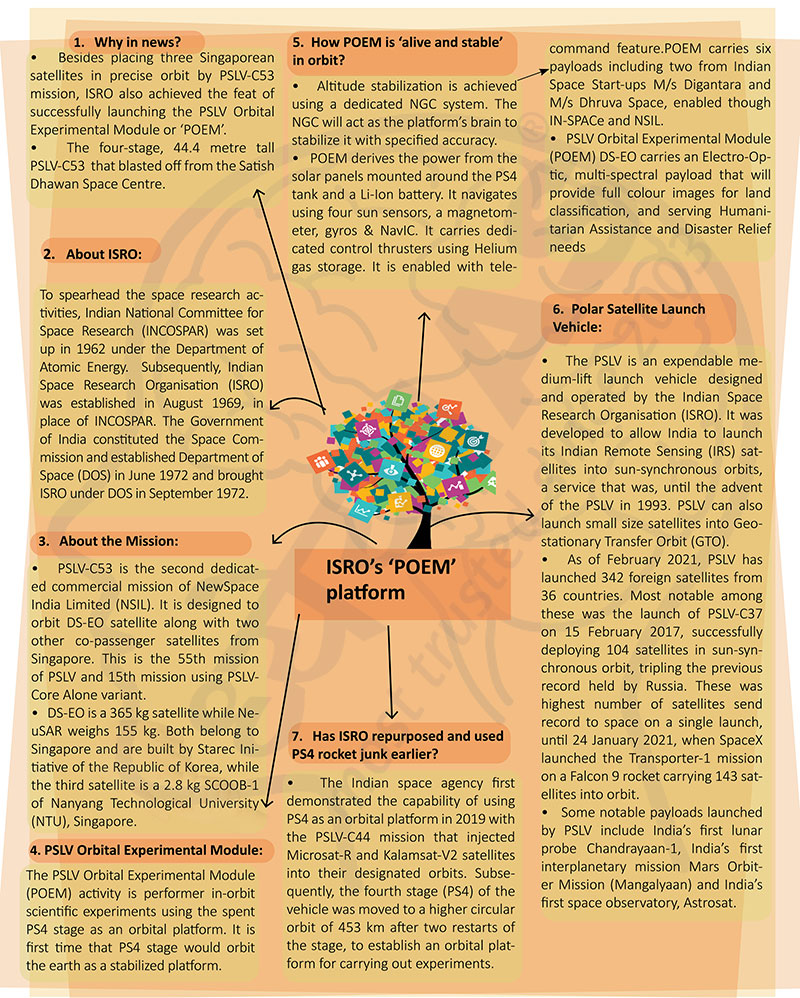Brain-booster /
12 Aug 2022
Brain Booster for UPSC & State PCS Examination (Topic: ISRO’s ‘POEM’ Platform)

Why in news?
- Besides placing three Singaporean satellites in precise orbit by
PSLV-C53 mission, ISRO also achieved the feat of successfully launching the
PSLV Orbital Experimental Module or ‘POEM’.
- The four-stage, 44.4 metre tall PSLV-C53 that blasted off from the
Satish Dhawan Space Centre.
About ISRO:
- To spearhead the space research activities, Indian National Committee
for Space Research (INCOSPAR) was set up in 1962 under the Department of
Atomic Energy. Subsequently, Indian Space Research Organisation (ISRO) was
established in August 1969, in place of INCOSPAR. The Government of India
constituted the Space Commission and established Department of Space (DOS)
in June 1972 and brought ISRO under DOS in September 1972.
About the Mission:
- PSLV-C53 is the second dedicated commercial mission of NewSpace India
Limited (NSIL). It is designed to orbit DS-EO satellite along with two other
co-passenger satellites from Singapore. This is the 55th mission of PSLV and
15th mission using PSLVCore Alone variant.
- DS-EO is a 365 kg satellite while NeuSAR weighs 155 kg. Both belong to
Singapore and are built by Starec Initiative of the Republic of Korea, while
the third satellite is a 2.8 kg SCOOB-1 of Nanyang Technological University
(NTU), Singapore.
PSLV Orbital Experimental Module:
- The PSLV Orbital Experimental Module (POEM) activity is performer
in-orbit scientific experiments using the spent PS4 stage as an orbital
platform. It is first time that PS4 stage would orbit the earth as a
stabilized platform.
How POEM is ‘alive and stable’ in orbit?
- Altitude stabilization is achieved using a dedicated NGC system. The NGC
will act as the platform’s brain to stabilize it with specified accuracy.
- POEM derives the power from the solar panels mounted around the PS4 tank
and a Li-Ion battery. It navigates using four sun sensors, a magnetometer,
gyros & NavIC. It carries dedicated control thrusters using Helium gas
storage. It is enabled with telecommand feature.POEM carries six payloads
including two from Indian Space Start-ups M/s Digantara and M/s Dhruva
Space, enabled though IN-SPACe and NSIL.
- PSLV Orbital Experimental Module (POEM) DS-EO carries an Electro-Optic,
multi-spectral payload that will provide full colour images for land
classification, and serving Humanitarian Assistance and Disaster Relief
needs.
Polar Satellite Launch Vehicle:
- The PSLV is an expendable medium-lift launch vehicle designed and
operated by the Indian Space Research Organisation (ISRO). It was developed
to allow India to launch its Indian Remote Sensing (IRS) satellites into
sun-synchronous orbits, a service that was, until the advent of the PSLV in
1993. PSLV can also launch small size satellites into Geostationary Transfer
Orbit (GTO).
- As of February 2021, PSLV has launched 342 foreign satellites from 36
countries. Most notable among these was the launch of PSLV-C37 on 15
February 2017, successfully deploying 104 satellites in sun-synchronous
orbit, tripling the previous record held by Russia. These was highest number
of satellites send record to space on a single launch, until 24 January
2021, when SpaceX launched the Transporter-1 mission on a Falcon 9 rocket
carrying 143 satellites into orbit.
- Some notable payloads launched by PSLV include India’s first lunar probe
Chandrayaan-1, India’s first interplanetary mission Mars Orbiter Mission (Mangalyaan)
and India’s first space observatory, Astrosat.








